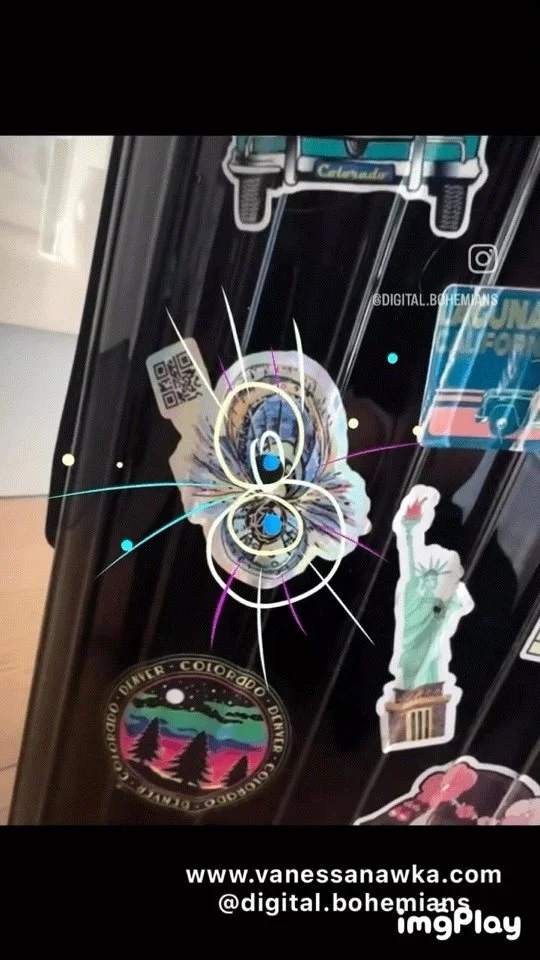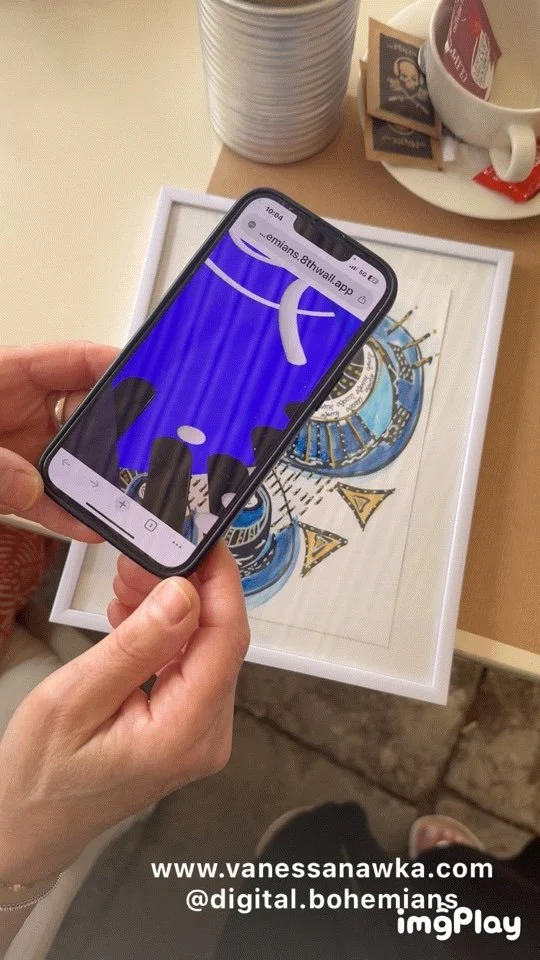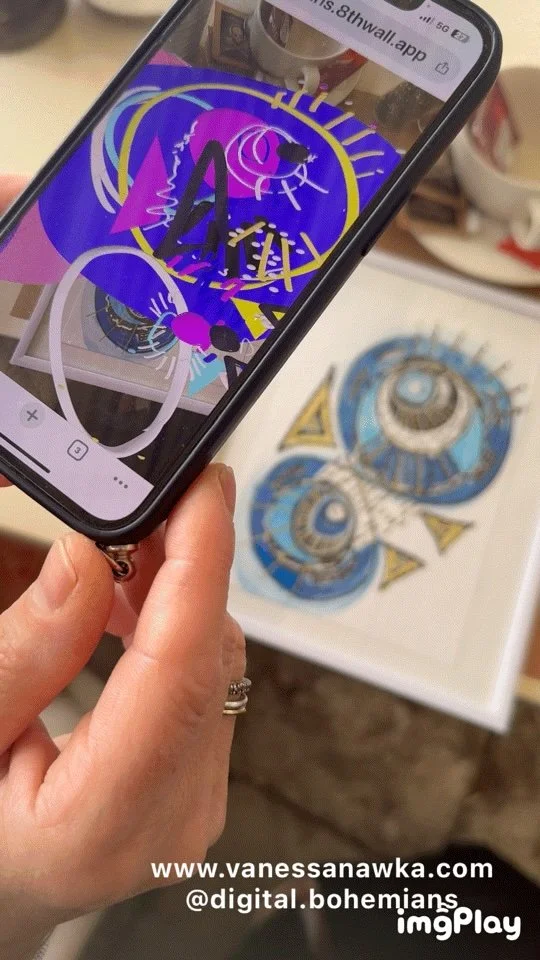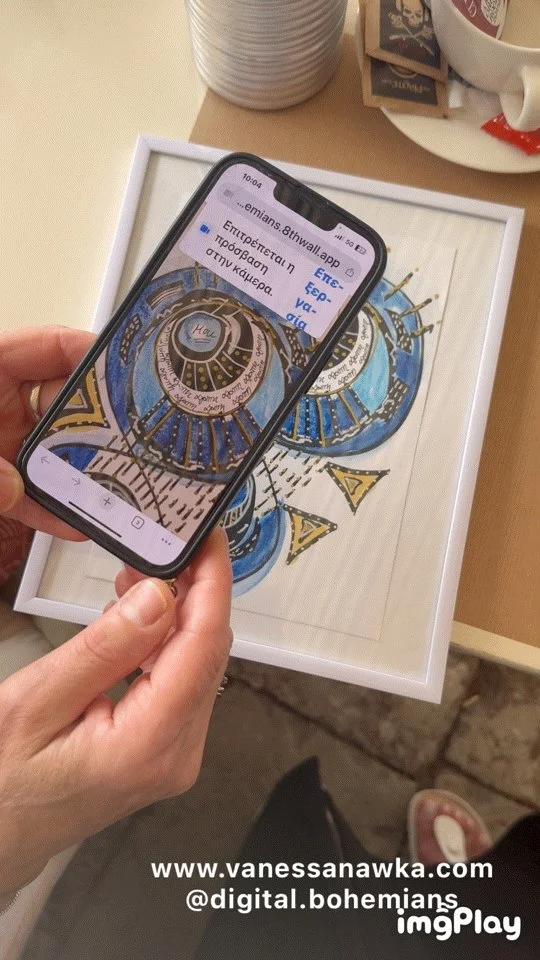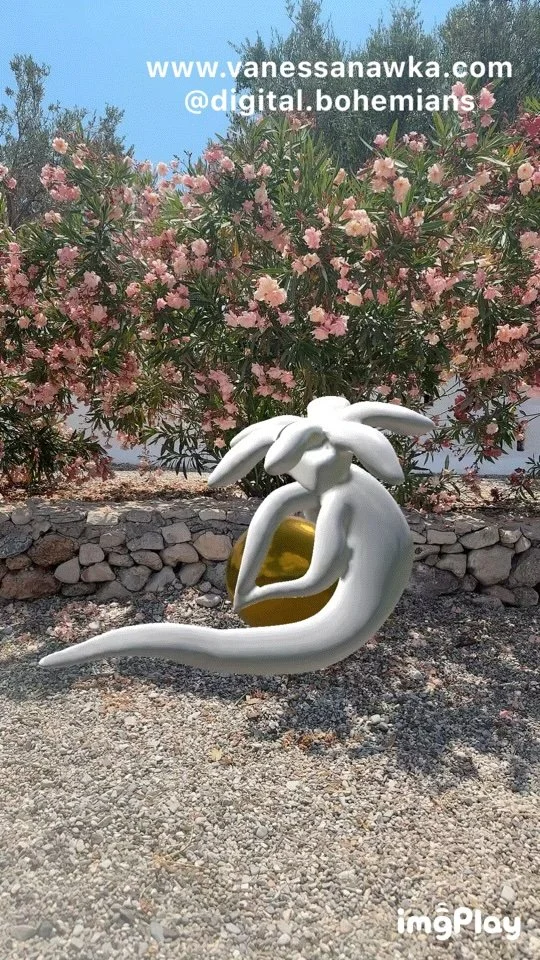A Life Between the Physical and the Digital: Vanessa Nawka on the Evolution of AR, VR, and the Greek Mati
By Cansu Peker
Vanessa Nawka is a mixed media artist whose work bridges spirituality and technology. Rooted in both painting and sculpture, her practice focuses on reinterpreting sacred symbols, most notably the Aegean Glyphs, inspired by the Greek Mati, and creating sculptural visions of the Divine. Her pieces exist both physically and digitally, often expanded through AR and VR into immersive environments that invite viewers to step into a living, breathing artwork.
Guided by a belief that spirituality and technology can coexist as tools of connection, Vanessa combines traditional craft with digital media to create what she calls “digital rituals.” Through 3D modeling, VR, and sound, she transforms ancient symbols into futuristic experiences. Her work becomes a holistic encounter with color, form, space, and sound, reminding audiences of the quiet, healing power embedded in art.
Most recently, I got to meet Vanessa in person when we spoke together on the panel The Evolution of Digital Art NFTs: Defining a New Art Movement at NFT.NYC’25. It was a treat to hear her perspective live — she brings such a thoughtful, grounded voice to conversations about where extended reality art is headed.
We asked Vanessa about her art, creative process, and inspirations.
Can you tell us about your background as a digital artist? How did you get started in this field?
I studied Visual Communication, with a solid base in fine arts like painting, drawing, and sculpture. During that time, I fell in love with sculpture and sculpting. Even my topics stayed the same, in the past they were much darker. I always enjoyed working with my hands, but I was also curious about digital tools. Even back then, I imagined how amazing it would be to create sculptures on an iPad.
At the time, that felt pretty far off. But now, in 2025, that vision has become part of my everyday life. For almost ten years, I’ve been working as a digital artist, combining what I learned through traditional art with tools like Blender, Gravity Sketch in VR, and Unity. These programs helped me build my own virtual art worlds - places where my sculptures and illustrations come alive.
Everything on the digital side, I taught myself. I learned 3D modeling, explored VR, and figured out how to make my work immersive and interactive. For me, digital art isn’t just a medium. It’s a way to extend what I already do — to invite people inside the artwork and let them experience it on a whole new level.
What’s it like creating as a husband-and-wife team? Do you naturally gravitate toward different parts of the process, or is everything shared?
While I’m the artist and founder behind the work - this is very much a female-led creative business - my husband plays an important role behind the scenes. He’s not involved in the creation itself, but he’s an incredible source of mental support and a big part of how I bring my exhibitions into the world.
We work closely together when it comes to curating shows. He helps me look at the artworks from a fresh perspective and supports me in finding inspiring locations around the world. Through traveling, he often helps identify unique venues that align with my vision. He also assists with organizing, curating, and sometimes even speaking at openings.
So while the creative core comes from me, it’s a beautiful collaboration when it comes to bringing the art into public spaces. His support allows me to focus fully on the artistic side, knowing that I have someone who believes in the work and helps carry it into the world.
Spirituality is a strong thread in your art. What does it mean to you to bridge spirituality with tech in a time when both are often seen as opposites?
For me, spirituality and technology aren’t opposites — they’re tools for connection. My work explores that in-between space where something ancient meets something futuristic. I often use symbols like the Greek Mati or embed healing intentions into my visual worlds, whether through color palettes inspired by nature or mythological forms that carry emotional resonance.
Technology allows me to amplify these messages. Through tools like AR or VR, I can create spaces that feel alive — not just visually, but emotionally. I want people to feel like they’re stepping into a breathing world that gently reminds them of something bigger than themselves.
Sound is an essential part of this experience. I’ve experimented with AI-generated music to create immersive soundscapes, but more recently I’ve started recording the Greek manifestations and affirmations myself — using my own voice to bring a deeper sense of presence and intention into the work. It becomes a holistic experience, engaging nearly all the senses. Of course, the only thing missing is the olfactory — but who knows, maybe one day!
We live in a time where the digital often feels cold or disconnected. My goal is to turn that on its head — to use digital tools as a bridge back to intuition, emotion, and even healing. In a way, I see my artworks as digital rituals — moments of quiet presence in a noisy world.
Can you tell us about the origins of the Aegean Glyphs? How did the reinterpretation of the Greek Mati become central to your work?
The Aegean Glyphs were born here on Hydra, a Greek island with no cars, a place that has preserved its energy and rhythm for decades. There’s something incredibly unique about this island. It’s said that the famous ley lines run just past it in the sea, but I’m quite certain they run straight through Hydra itself. You can feel it.
My connection to Greece runs deep. My father grew up here, and my grandmother lived on the island of Evia for many years. Greek was spoken in my family - my father, my aunt, my grandmother - and I grew up hearing and speaking it as a child. I was brought to Hydra as a baby, so this island isn't just a place. It's part of my roots.
The Mati, the Greek evil eye, is a beautiful and powerful symbol of protection. I've always loved its aesthetics, but even more so its deeper meaning. At some point, I felt drawn to make it the core of my artistic work. What started as a personal fascination evolved into a full visual language and eventually into Augmented Reality.
Using AR, I reimagined the Mati as something interactive and immersive. These digital paintings, created with mixed media and oil pastels, now move, speak and glow. They are accompanied by sound, spoken affirmations and 3D animation, making them feel almost like modern guardians or spiritual companions in the digital age. Like Greek icons, they carry meaning and presence, but they have been transformed into something new and personal. Something living.
Through Extended Reality, they come to life in the real world. When viewed through a mobile phone or tablet, they appear as if through a window into another dimension. They allow people to experience a moment of connection, protection and quiet presence, no matter where they are in the world.
You work across both physical and digital forms. How do you decide when a piece should be a sculpture, a painting, or exist in AR — or all three?
Most of my real-world mixed media paintings are designed to be experienced with AR. That’s an essential part of my practice. The idea is that the painting isn’t the final step, it's just the beginning. With Augmented Reality, these works become alive, extend beyond the surface, and open a window into a more emotional, layered world.
My VR paintings, on the other hand, are purely digital and abstract. They’re more intuitive and often created as a personal balance to my main job as a UI/UX designer at Audi Design. Sometimes I bring them to life with AI, but they mostly remain immersive, meditative pieces made to exist within VR only.
My sculptures usually begin as a sketch or directly within my 3D program. It feels like working with digital clay - shaping form out of emotion. That process is also meditative. Both paintings and sculptures come from within me, from memories, thoughts, and feelings I need to express. They are glimpses into my inner world, transformed into something that can give others comfort, beauty, and a sense of connection.
I want my art to feel alive. I want it to be colorful, musical, interactive, like life itself. My hope is that people feel something when they experience it. That they remember they’re not alone. Even if it’s not always visible, we are all connected.
My Glyphs of the Aegean are mixed media paintings created with the energetic saltwater of Hydra. They are refined with gold pigments and handwritten Greek affirmations. My VR paintings also follow the Mati theme, but they exist exclusively in virtual space and stay digital. My sculptures start on paper, are shaped on the iPad, and brought to life in Blender where I rig and animate them. They can be experienced in the real world through my TikTok account using AR, and lately, I’ve even started 3D printing them at home. From digital to physical, they are sanded and lacquered by hand.
What has been the most exciting or unexpected challenge in bringing your physical artworks to life through AR?
For me, bringing physical artworks into AR is always a transformation. A development. As an artist, I believe that standing still means losing the opportunity to evolve. That philosophy shapes my entire creative process.
When I first started experimenting with AR, it felt like entering a completely new dimension. The technology was still in its early stages and in many ways, it still is. One of the biggest challenges has been accessibility. AR is not always cross-platform, and many solutions require users to download special apps. That creates a barrier, and I’ve always wanted my art to be inclusive and instantly accessible.
Over time, I found ways to integrate AR into my work that don't require extra downloads. Now, my audience can experience my sculptures and paintings directly through mobile devices, using familiar platforms like Instagram, TikTok or web-based AR. That was a breakthrough moment. Suddenly, the artwork could appear anywhere: in someone’s living room, in the street, in nature and as a living extension of the physical piece.
What’s unexpected, but beautiful, is how this process mirrors the art itself. Each transformation from canvas or sculpture into AR feels like a metamorphosis. The artwork continues to grow beyond the frame, beyond the object — and it carries something emotional with it. It becomes a shared experience, not just something to observe, but something to feel.
That’s what keeps me going. Exploring new ways to make the invisible visible.
It was such a pleasure sharing the panel with you at NFT.NYC — what were some takeaways from that experience that stayed with you afterward?
It was incredibly inspiring to see that I’m not alone in believing in the evolution of art through digital expression. Being surrounded by others who share that same spirit and vision gave me a real sense of belonging. Often in the traditional art world, there’s still hesitation or even resistance when it comes to digital mediums, especially things like AR, VR, or NFTs.
That’s exactly why I choose to do both. I live between the physical and the digital, and I see them not as separate worlds, but as parts of the same story. NFT.NYC reminded me that there’s a growing global community of artists and thinkers who feel the same. That energy has stayed with me.
Was there anything you didn’t get to say during the panel that you wish you had?
I wish I had spoken more about how strongly I believe in the future of AR and extended reality. For me, it’s not just a tool for artists, it’s a shift in how we experience the world. One day, I truly believe we’ll all be wearing lightweight AR glasses that include personal assistants, creative overlays, and live content tailored to our surroundings.
Imagine walking through a city and seeing historic landmarks enhanced through AR layers, or stepping into a gallery that exists entirely in extended reality, accessible from anywhere in the world. That’s exactly the kind of immersive experience I’m building with projects like digitalbohemians.club. My goal is to make art more accessible, more emotional, and more connected — no matter where the viewer is.
These possibilities excite me, not just as an artist, but as a human being. AR will change how we live, learn, feel, and share stories. I just wish I had had the time to say that on the panel.
What else fills your time when you’re not creating art?
When I’m not creating art, I work as a UI/UX designer at Audi Design, where I focus on intuitive digital experiences — which, in many ways, complements my artistic vision. Design and art feed each other in my life, and both are rooted in storytelling, empathy, and the human experience.
I also spend a lot of time in virtual reality. There, I not only explore immersive spaces, but also organize exhibitions and guide meditation sessions that people from all over the world can join. VR has no borders — and I love how it creates a shared presence that feels both intimate and expansive at the same time. It's a space where art, mindfulness, and community come together.




